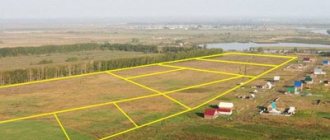Home / Real estate / Land / Size of land
Back
Published: 11/16/2017
Reading time: 8 min
0
659
When forming land for private household plots, peasant farms and agriculture, it is necessary to take into account the maximum size of plots. Such sizes are determined either by the law of the subject or by order of the local administration. Failure to comply with the established plot sizes will result in the impossibility of registering the land in the cadastral register.
- Legislation on sizes
- Limit sizes for private household plots, peasant farms and agriculture Minimum parameters
- Maximum parameters
Basic requirements for created and modified areas
At the moment, in order to implement sustainable economic development throughout the country, public policy is forced to effectively use natural and, in particular, land resources, that is, to comply with the maximum minimum size of a land plot and the norms for the provision of plots specified in the legislation.
In addition, the land must be actively involved in civil circulation, and this inevitably entails the formation of new areas and their changes.
The main document stipulating land relations in these matters is the relevant Code and the requirements for the newly formed and changed land plots are quite clearly indicated in the said document:
- The main one of these requirements is strict adherence to the maximum and minimum sizes specified in urban planning regulations and state laws, depending on their scope.
- It is imperative to ensure that when creating or changing sites, there are no intersections of their established boundaries with existing lines limiting the territory of municipalities or settlements.
- It is impossible to allow the appearance of such plots of land that make it impossible to use the construction projects already built on them in accordance with the type of their use determined by law.
- The division or other formation of plots must comply with restrictions and encumbrances that do not allow their intended use, in accordance with those established by law.
- It is not permissible for defects to appear as a result of the formation or change of sites that interfere with the rational use of land or contribute to its impossibility: wedging, interspersing, interstriations or excessive broken boundaries, as well as the impossibility of legal buildings.
When forming or changing land belonging to state or district property, these rules are necessary requirements that must be followed.
Established maximum sizes of land plots
- familiarize yourself with local town planning regulations and land use rules (requirement of Article 32 of the Civil Code);
- study the zoning map to find the plot and find out the exact location along with the location of other objects (access to the plot must be provided, it cannot go beyond the territory of the settlement and district);
- read the basic conditions and requirements for development, so as not to violate the height and number of floors, as well as the size of the area allocated for the house;
- use the services of a geodetic company to draw up a demarcation plan and draw up an act indicating the exact boundaries of the site.
- The size of the plot depends on its purpose (Article 33. Norms for the provision of land plots). This is farming and peasant farming, gardening and vegetable gardening partnerships, country house construction and raising various types of livestock or poultry. After allocation, private individuals have the right of ownership of land (clause 1).
- The maximum size (clause 2) varies somewhat and is determined by federal laws and local regulations. In some cases (clause 2.1) a gratuitous transfer is stipulated, affecting large families. There are also a number of restrictions (clause 3).
- The boundary dimensions and location of the plot should not violate accepted standards and extend beyond the territory of the populated area (Article 11.9. Requirements for created and modified land plots). The land must be suitable for exploitation. Cutting that leads to wedging, striping or encroachment into forest parks and nature reserves is unacceptable.
- The procedure for obtaining a cadastral plan and passport follows a certain scenario (Article 11.10. Layout of a land plot or land plots on the cadastral plan of the territory). The concept of a scheme, the number of required documents, the participation of other persons in the registration process, the preparation of media, the rights of the owner and the actions of local authorities are spelled out.
- There are restrictions for certain categories of land (Article 27. Limitations on the turnover of land plots) provided for natural parks, burial sites, the location of military units, communication lines, roads and railways.
Norms for the provision of land plots
The norms for the provision of land plots for the use of citizens, provided for peasant farms, gardening and vegetable farming, livestock farming or the construction of summer cottages from lands that are not municipal or state property, are established in the laws of the constituent entities of the Russian Federation for each individual local government body.
The maximum norms for the provision of land plots allowed for free use by citizens, established in the listed rules for certain purposes, are regulated in:
- federal laws - from land in federal ownership;
- laws of the constituent entities of the Russian Federation - from lands belonging to these constituent entities;
- regulatory acts of local self-government - from the lands given to them as property.
However, for purposes not specified in the article specifically designated for this, lands are allocated in accordance with the rules established for this: the norms for the provision of land plots for such cases are regulated in the design, urban planning or land management documentation.
Limit sizes of land plots for individual housing construction
In cases where land territories are of federal significance, maximum and minimum standards, including when dividing plots, are regulated by federal legislation. Accordingly, the area of land owned by the municipal body, as well as regional authorities, will be determined in accordance with local regulations.
- Application requesting registration of your property rights;
- Copy of passport and identification code;
- Receipt for payment of state duty;
- Acts on the provision of land;
- Other documents of title (will, certificate of inheritance, deed of gift, rent or exchange agreement, purchase and sale, etc.).
Impossibility of crossing the borders of municipalities and settlements
Lands of settlements are considered to be lands intended for construction and future development of these settlements. The boundaries of such points separate them from lands intended for other categories. They cannot intersect with the boundaries of municipalities or go beyond them, or intersect with land plots provided for the use of citizens or legal entities.
The lands of this category represent only a small part of the territory belonging to the Russian Federation, but they play a fairly important role in the social and economic development of the entire state.
These lands are characterized by a high level of anthropogenic impact and intensity of use. They are associated with a number of problems that need a quick and adequate solution, otherwise they can lead to a significant deterioration in the quality of life of people in these territories.
Interspersed and broken boundaries on such lands lead to the inevitable emergence of a large number of conflicts of interests of the most diverse nature, therefore, when creating new areas, it is unacceptable to resolve such an oversight.
Interspersing is practically unacceptable for limited areas of settlements, in which the number of vehicles is rapidly increasing, which causes economic, aesthetic, social and even environmental conflicts between the owners of individual plots and the population as a whole, especially taking into account the constantly growing number of personal vehicle fleets owned by different citizens .
For domestic land law, it is traditional to classify lands belonging to settlements as a separate category. Formally, federal legislation does not provide for a separate legal status for various types of settlements, although special rules have been established for them to delimit the possible use of land.
Land legislation determines the impossibility of the permitted use of real estate and land due to the formation of a fracture, inclusion or wedging, or the intersection of their borders with forest parks, parks or other territorial zones.
We must not forget that a land plot is primarily considered by the state as an object of state cadastral registration, therefore it should be considered as meeting the tasks set by the state, taking into account the implementation of administrative reforms. This is precisely what explains the impossibility of forming land plots in which there will be interspersing or wedging or other impossibility of constructing and using real estate for the permitted purpose.
In essence, a land plot can be called a part of the planet’s surface with legally defined boundaries that comply with federal laws.
The requirements put forward for new land plots are therefore required to comply with these laws, therefore changes such as interspersing, wedging or other clarification that do not allow for the legal construction of real estate that would be made for legally permitted purposes cannot be legalized. .
Author of the article
Minimum Maximum Sizes of Land Plots for Agricultural Purposes
6. Town planning regulations are not established for lands of the forest fund, lands covered by surface water, reserve lands, lands of specially protected natural areas (except for lands of medical and recreational areas and resorts), agricultural lands as part of agricultural lands, land plots located in boundaries of special economic zones.
We recommend reading: Insurance amount of bank deposits
as a result of this cadastral registration, the area of this land plot, determined taking into account the requirements established in accordance with this Federal Law, will be greater than the area, information about which regarding this land plot is contained in the state real estate cadastre, by an amount greater than the maximum minimum size of a land plot established in accordance with federal law for lands of the corresponding intended purpose and permitted use, or, if such a size is not established , for an amount of more than ten percent of the area , information about which regarding this land plot is contained in the state real estate cadastre
Minimum garden plot size in the Leningrad region
REGIONAL LAW ON THE LIMIT SIZE OF LAND PLOTS PROVIDED TO CITIZENS IN THE OWNERSHIP OF LAND OWNED BY THE STATE OR MUNICIPALITY AND THE MAXIMUM SIZE OF THE TOTAL AREA OF LAND PLOTS THAT MAY BE LOCATED SIMULTANEOUSLY ON THE RIGHT OF OWNERSHIP AND (OR) OTHER RIGHT OF CITIZENS RUNNING PERSONAL SECONDARY FARMS
The minimum area of a garden plot depends on the permitted purpose: for dacha construction this is one area, for a farm it is another. It is characteristic that changing the purpose of land is a very labor-intensive and expensive task, despite the fact that many experts have been recommending for several years that the federal government reconsider its attitude and equalize the rights and assignments of SNT, DNT and individual housing construction lands, limiting their size - most often to 30 hundred square meters and introducing a system of self-declarations.
Definition
Land for agricultural use is an allotment provided to an individual or legal entity for conducting personal subsidiary farming or agricultural activities. It is located outside the populated area and is distinguished by soil fertility or other characteristics that allow benefit to be extracted through the cultivation of fertile soils or in another manner consistent with the intended purpose of the land.
If you have questions about extracting from the household ledger , read our article.
Ship practice
The branch of the Federal State Budgetary Institution "FKP Rosreestr" decided to refuse to provide registration services and register a certain property, based on the standards specified in paragraph 2 of Article 27 of the Cadastre Law, as well as in the Law of the Nizhny Novgorod Region No. 58-3, adopted on July 14 2003.
Based on the decision of the court of first instance, the applicant was refused to satisfy these requirements, and therefore filed an appeal demanding the cancellation of the decision of the court of first instance.
Ultimately, the appellate court returned the said case for retrial to the court of first instance, but at the same time gave its own explanations regarding the fact that the rules that were specified by this branch in the process of making a decision on refusal can be applied in the process of providing land plots to individuals into ownership from those territories that are owned by state or municipal bodies. Thus, they cannot be used if a land plot that is the property of citizens is transferred.
At the same time, in another case, the appellate court took the opposite position, in connection with which it can be noted that any unified judicial practice on the use of legislative norms in determining the minimum size of land plots has not yet been formed, and therefore the final result may directly depend on the characteristics of the case under consideration and the court in which it is being heard.
Private household plot
- This is a personal subsidiary plot, which is not intended for the construction of buildings and structures.
What is registration of ownership of a plot - read in more detail in this article.
The rules for registering a land plot are indicated here.
Selection of the most important documents upon request Minimum size of land plot
(regulatory legal acts, forms, articles, expert consultations and much more).
Regulatory acts: Minimum size of land plot
Articles, comments, answers to questions: Minimum size of land plot
Guide to judicial practice. Sale of real estate In accordance with p.
.
1 tbsp. 35 of the Land Code of the Russian Federation and clause 3 of Art. 552 of the Civil Code of the Russian Federation, when selling real estate located on a land plot that does not belong to the seller by right of ownership, the buyer acquires the right to use part of the plot occupied by this real estate and necessary for its operation
.
As follows from paragraph 2 of Art. 35 of the Land Code of the Russian Federation, the maximum dimensions of the area of part of the land plot are determined in accordance with clause 3 of Art. 33 of the Land Code of the Russian Federation, taking into account the approved norms for land allocation for specific types of activities or rules of land use and development, land management, urban planning and design documentation
.
These norms are no longer in force on March 1, 2015
.
in accordance with Federal Law dated June 23, 2014 N 171-FZ. At the same time, according to Part
.
20 tbsp. 34 of this Law, before approval in the manner established by the Town Planning Code of the Russian Federation, the rules of land use and development for the purposes of the formation and provision of land plots in state or municipal ownership, those established before the date of entry into force of the said Law in accordance with Art
.
33 of the Land Code of the Russian Federation, maximum (maximum and minimum) sizes of land plots.
Guide to judicial practice. Trust management of property By notification dated 05/06/2003, the defendant informed the plaintiff about the suspension of registration of the agreement until 06/05/2003
.
The plaintiff was asked to confirm the right of the founders of the management to conclude an agreement dated April 28, 2003. After the expiration of the specified period, the plaintiff was denied the application with reference to its lack of conclusion, since its subject is not certain property, but shares in the right, the transfer of which is actually impossible
. The justice institution also referred to the fact that the applicant did not submit a plan of the land plot with boundaries established on the ground indicating its cadastral number, and that in accordance with Article 22 of the Law of the Krasnodar Territory “On the basics of regulation of land relations in the Krasnodar Territory” the minimum size land plots formed from agricultural lands and necessary for agricultural production are at least 300 hectares, while the total size of the land plot taken by the trust company for trust management under the agreement dated April 28, 2003 is only 59.8 hectares.
In the 90s, the land was announced to be transferred to private ownership. Unlike the Soviet era, when all land belonged to the state, now citizens are allowed not only to use the land, but also to privatize
. Privatization is the transfer of real estate from the hands of the state to the hands of citizens.
Land is a valuable natural and economic resource. To ensure that it was not used thoughtlessly, restrictions were introduced on the maximum allowable size of plots
. Each type of activity has its own limit and this is advisable.
Minimum permissible holding sizes are established to control the haphazard subdivision of plots.
In pursuit of profit, owners divide their land, which interferes with farming and building facilities. Ultimately, it also causes economic and environmental harm.
Legislative framework on plot sizes
When determining specific plots for a peasant farm (peasant farm), personal subsidiary plot (LPH), KFK or agricultural production, it is imperative to take into account the maximum possible legal size. This determination is made by representatives of the local administration or the current government of the constituent entity of the Russian Federation. If the size of the plot is too large, the owner will be denied entry into the cadastral list. Such a system makes it possible to prevent the accumulation of land plots under one owner or from small fragmentation of the territory.
Federal normative act “On Peasant Farming” No. 74 dated June 11, 2003 presupposes the possible size of land plots. To carry out targeted activities.
Table: Possible dimensions of plots.
| Locality | Minimum value | Maximum value |
| Moscow | 0,02 | 40 |
| St. Petersburg | 0,06 | 50 |
| Pyatigorsk | 0,06 | 50 |
| Novosibirsk | 0,04 | 50 |
| Khabarovsk | 0,1 | 50 |
| Ekaterinburg | 0,1 | 50 |
| Nizhny Novgorod | 0,03 | 25 |
| Rostov-on-Don | 0,08 | 50 |
Like the minimum values, the maximum parameters of peasant farms and agricultural lands are regulated by the legislation of the subject of the Russian Federation.
Important! Territories with boundaries that were previously determined, have a cadastral number and have received an owner are not subject to comparison with the current parameters.
Regulatory acts and urban planning regulations
Today, the sanitary minimum provides for a certain factor, according to which lands can be classified or not classified as divisible. This standard is established by the norms prescribed in Law No. 136-FZ, adopted on October 25, 2001.
Regional authorities, in accordance with current legislation, are given the opportunity to make adjustments to the minimum size of areas, but this can only be done upward.
Today, municipal authorities are in charge of determining the required areas for various land plots, which are provided to citizens from the list of lands intended for agricultural activities, used for all kinds of gardens, vegetable gardens or subsidiary plots.
The activities of executive committees in any case must be carried out in accordance with the norms prescribed in paragraph 1 of Article 33 of the Land Code.
Article 33. Norms for the provision of land plots







